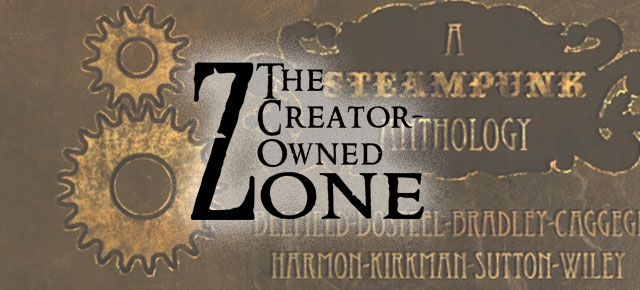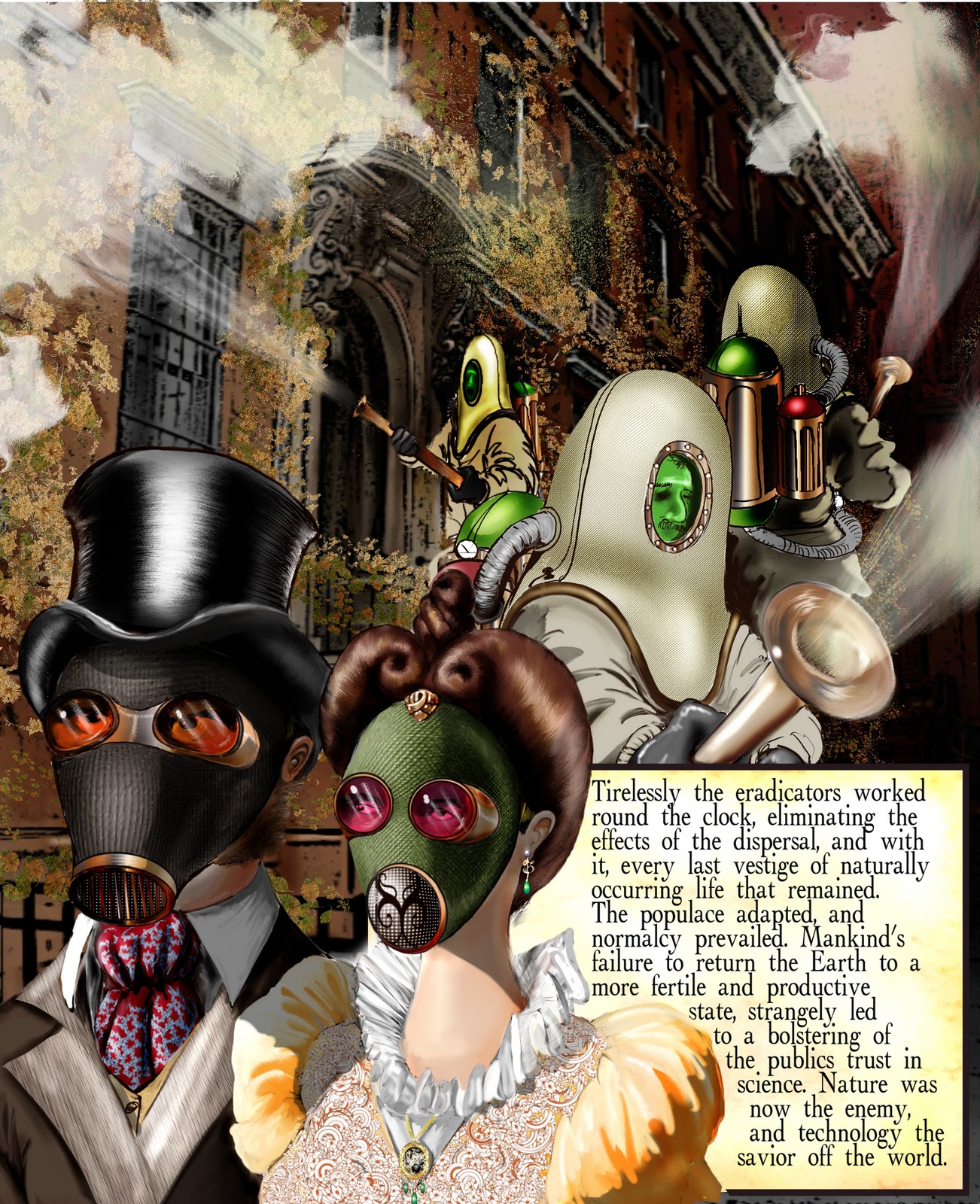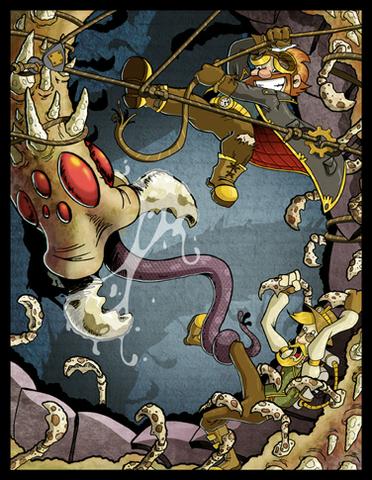Review – 8: A Steampunk Anthology
 The illopond Creative Collective is a stable of independent artists who put a focus on the creation and distribution of their own original work, and 8: A Steampunk Anthology is their latest collaboration, a follow-up to 8: A Kid’s Book Anthology. Given the focus illopond puts on the creative autonomy of the artist, every story included in this anthology is written and drawn (as well as, I would presume, colored and lettered) by a single creator as opposed to a creative team. Steampunk seems like a great fit for such artist-driven narratives, given the prominence of visuals and aesthetic in the genre. Right away, the graphic novel makes a good first impression with a cover that’s simplistic but immediately evocative of this steampunk aesthetic. But how does the material inside – the stuff that really counts – hold up?
The illopond Creative Collective is a stable of independent artists who put a focus on the creation and distribution of their own original work, and 8: A Steampunk Anthology is their latest collaboration, a follow-up to 8: A Kid’s Book Anthology. Given the focus illopond puts on the creative autonomy of the artist, every story included in this anthology is written and drawn (as well as, I would presume, colored and lettered) by a single creator as opposed to a creative team. Steampunk seems like a great fit for such artist-driven narratives, given the prominence of visuals and aesthetic in the genre. Right away, the graphic novel makes a good first impression with a cover that’s simplistic but immediately evocative of this steampunk aesthetic. But how does the material inside – the stuff that really counts – hold up?
The first story is Tamerlane Waller and the Tentative Temporal Timestealer, by Carsten Bradley. The story – as the title effectively suggests – is a play on the Sherlock Holmes stories and other such Victorian-era mysteries, with the hero in this case a mouse, paying a visit to the local gaol to meet his captured Moriarty, an owl called Galbraith. This is a nice little tale that seems to set up expectations with the reader, based on the familiarity with the adventures it’s riffing on, only to then reverse those expectations and end on a surprisingly touching note. The art style is very simple, using a lot of shade and silhouette, and very little in the way of color – making Galbraith’s glowing red eye stand out all the more menacingly. This makes for some enjoyably atmospheric storytelling, though this does come at the expense of detail on occasion. If I had any criticism of this story, it would probably be its placement as the first tale in the collection. I imagine a lot of readers are like me, in that they only have a basic sense of what steampunk is about rather than a detailed familiarity. As such, an opening story which more clearly lays out the tropes of the genre might have been wiser than a story which, as well as being a twist on the genre given that it involves animals as protagonists, is one of the least obviously steampunk of all the stories in the anthology. If not for the occasional sketchy zeppelin shot, this could just as easily have been a twist on a regular Victorian era period piece. But semantics aside, this was an enjoyable story, and in terms of quality, at least, sets the anthology off on the right foot.
Decisive Moments: Tales of the Great Steam War, by Warren Belfield, may have been a better choice to go first. Belfield captures much of what I think of based o my understanding of steampunk: an alternate history built on a different technology, the melding of old with futuristic (concisely demonstrated with the design of the protagonist’s father: a 19th Century style British soldier with a cybernetic arm). His crisp artwork does much to create a sense of time and place, with the slightly yellowed grayscale color scheme making the whole story look like century-old photographs, or an early film reel of a forgotten time. The story is brief, and – as is often the case with good anthology shorts – could probably have benefitted from a more generous page count. But in the space he has, Belfield manages to deliver a self-contained narrative that covers a lot of ground, but, to avoid become sprawling, skilfully confines its focus to a single idea: what a son learns from his soldier father, and how he applies that lesson upon becoming a soldier himself.
The third story, Thoroughbred by Zach Bosteel, is one of the weaker efforts in the anthology. The idea behind the story is good enough: the simple but effective conceit of an ingenious but scatterbrained inventor and his cynical, ass-kicking daughter going on adventures and seeming to piss off everybody they encounter despite their best efforts is strong enough to support plenty of stories. And in his writing, Bosteel manages to live up to the promise of the concept for the most part. But as we progress through the remaining stages in the creative process, problems emerge. The artwork is a mixed bag. At some points, such as in a dramatic train crash, it’s exciting and kinetic. But a lot of the time it suffers from cluttered panel layouts and inconsistent character design that make it awkward to get a clear grasp on what’s going on. The waters are further muddied by coloring that, while rendered well in the backgrounds and scenery, too often becomes sloppy when applied to the characters, blotting out much of the details and creating a blocky effect. But perhaps most damaging of all is the lettering work. I’ve talked before about how underappreciated lettering is. It has been said that the only lettering that is noticed is bad lettering, and Thoroughbred becomes an unfortunate example of that. While lettering is supposed to lead the eye along the page, too often the lettering here leads the eye in the wrong direction, and bubbles are placed awkwardly in a way that it at times becomes difficult to read conversations in order, or even tell who’s supposed to be speaking. Even something as simple as the shape of the bubbles or the font can be distracting and take you out of the story when not done right. It’s a shame: even given my issues with the art, a strong letterer could have accentuated the strengths and downplayed the weaknesses in this story, rather than downplaying the strengths and accentuating the weaknesses as has happened here. Thoroughbred shows that sometimes there is a benefit to having a creative team collaborating in comics rather than one person trying to be a jack of all trades.
In contrast, the next story – For the Public Good by Samuel E. Kirkman – has some of the most beautiful artwork of the whole anthology, and demonstrates just how much visuals can elevate the words of the narrative to a whole new level. Kirkman’s lush, painterly art is rich with depth and detail, help creating the most fully-realised steampunk world of all the stories contained in 8. The imagery contained shifts easily from the graceful to the nightmarish, with the realistic facial expressions enhancing the emotional connection. Even if there had been no words in the story, the pictures alone would have made For the Public Good a rewarding tableau for any reader. But there are words, with the dialogue being put ably to use as a foreshadowing tool, and a science VS nature argument beginning to take shape. I do have one problem, which I’ll go into more detail with later, with another story in the anthology that’s a worse offender. But overall, this is a haunting, visually splendid read, and one of the highlights of the collection.
Data Point by Paul Caggegi is an interesting piece. It serves as a showcase for the benefits of a single creative voice telling a story in the comic medium, with words
seamlessly integrated into the images, both working in unison to guide the eye and shape the page. In a lot of ways, this doesn’t feel like a conventional comic. There are no speech bubbles, with dialogue instead relayed in prose style, and the narration is not contained in captions, flowing freely through the page and sometimes filling entire image-free panels. Unconstrained by conventional comic book language, Caggegi is free to craft an unusual, visually ambitious story filled with memorable, powerful imagery. The story itself is emotionally resonant, dealing with big ideas such as, What makes us human? and How do we define a soul? Caggegi certainly marks himself out as a creative voice of note here who, given an opportunity on a larger platform, could do some really exciting stuff not often seen in comics and change some people’s minds about what it’s possible to convey in the medium.
Star Junkers, by Clint Sutton, can’t help but feel a bit underwhelming after following such an impressive double-bill. The cartoony art is charming enough, but again, flat coloring and sloppy lettering let the side down at points. The plot, about two cute little aliens landing on a desolate planet and finding a new robot friend, doesn’t really do anything but chug along uneventfully. The characters go to the planet, look around a bit, and then leave. It doesn’t really say much, or offer much scope for characterisation. I get that this seems more of an all ages story, but even so the story could have used a little more flavour.
On the other hand, Pest Control by Mark Harmon is a delight, possibly my favourite story of the anthology. It too seems targeted at an all ages audience – Harmon’s biography tells us that this is his first comic after building up a body of work doing children’s books – but it shows the kind of wit, charm and energy that can excite children while keeping the grown-ups interested too. The story follows a pair of monster hunters going about their daily work, and is based mostly around a montage of increasingly absurd single-page battles. Simple enough, then, as far as the writing goes, but the joy really comes from Harmon’s art. You can tell he had a great time designing the various monsters that our intrepid heroes Conrad and Trigger do battle against. The stylised art is wonderfully expressive, and has a great flow and sense of energy about it. And the story is crammed with visual gags: the bank-robbing werebeaver makes me chuckle every time I look at it. The story wonderfully demonstrates the kind of boundless, unfiltered imagination comics can offer an ideal outlet for. Pest Control is a fun romp, and if Harmon is this adept with the tools at his disposal in his first comic, he’s only going to get better as he gains experience in the field.
Finally, we have Exodus by Lee Wiley. It’s an entertaining, intriguing story that sets up some interesting ideas to be explored. But that’s my problem with it, too. It’s quite clearly set-up for a larger story, so it feels like we’ve barely been introduced to this world Wiley is establishing and our main characters before the preview is done. This is a bit of a pet peeve of mine when it comes to anthologies. Now, I understand why it’s a good idea for creators and the benefits that can come from showcasing a sample of a larger work and getting more eyes on it, and maybe my opposition to it is a bit irrational, but I just think that stories in an anthology should be self-contained. Short stories seem to be a dying artform as it is: once the likes of Edgar Allen Poe were telling masterpieces in the format and The Twilight Zone was giving us chilling one-and-dones on TV every week, but now the venues for short stories are becoming increasingly obscure and many writers of all mediums are seeing it as a less and less viable format. So when we do get a treat like this – an anthology perfectly catered to the endangered short story – it’s frustrating to see space taken up by chunks of a bigger story. It downplays the craft of the self-contained short story. For the Public Good was also guilty of this – being a prequel to Kirkman’s Grew – but that seemed to make more of an effort at being somewhat self-contained. Exodus, however, feels like chapter 1, with nothing resolved as the story comes to its conclusion. However, it’s well-written and well-drawn enough that I’d be interesting in reading the larger story once it becomes available.
So, as tends to be the case with most anthologies, some of the stories in 8: A Steampunk Anthology are better than others. But there are more hits than there are misses here, so that makes this a winner in my book.
***
Creators: Carsten Bradley, Warren Belfield, Zach Bosteel, Samuel E. Kirkman, Paul Caggegi, Clint Sutton, Mark Harmon, Lee Wiley
Publisher: illopond Creative Collective
Price: $16.50
Synopsis: Tamerlane Waller and the Tentative Temporal Time-stealer is a heartwarming tale of redemption and intrigue. Decisive Moments centers on the price of war and one family’s ancestral allegiance to it’s call. Thoroughbred is a raucous story of a well meaning inventor and his butt kickin daughter, caught between the bad guys and the good guys. For The Public Good is a tragic tale of the human price for scientific failure. Data Point is one mans epic journey from the loss of his mate to the end of our solar system. Pest Control is a wild west steam powered monster mash. Exodus is the beginning of one young mans journey to discover a better world in a dystopian future.
the 8 group of artists, in association with the Illopond Creative Collective bring to you a comic anthology of Steaming Greatness. Steampunk Greatness that is. Eight Artist/Authors, From around the world, have collaborated together to produce a remarkable collection on comic tales. 8 authors, 8 stories, 8 pages each, 8 different take on the popular Steampunk aesthetic. From Whimsical to tragic, From the distant future, to a parallel past, there is something for everyone.
8: A Steampunk Anthology is now available to buy through IndyPlanet.
Related Posts:
Category: The Creator-Owned Zone



















